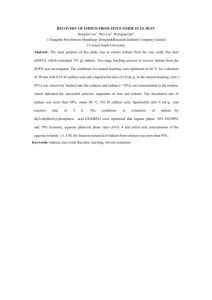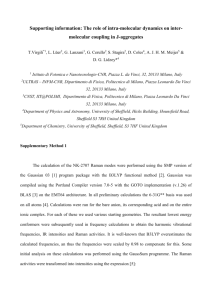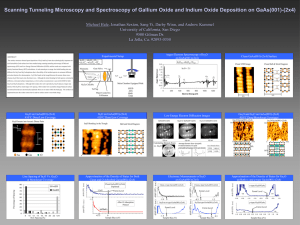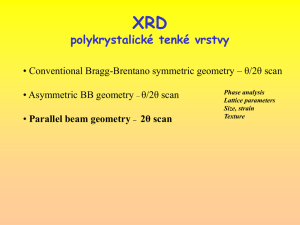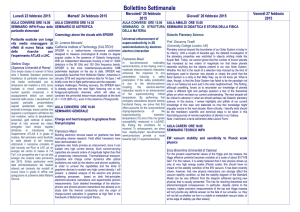29226 - جامعة الملك عبدالعزيز
advertisement
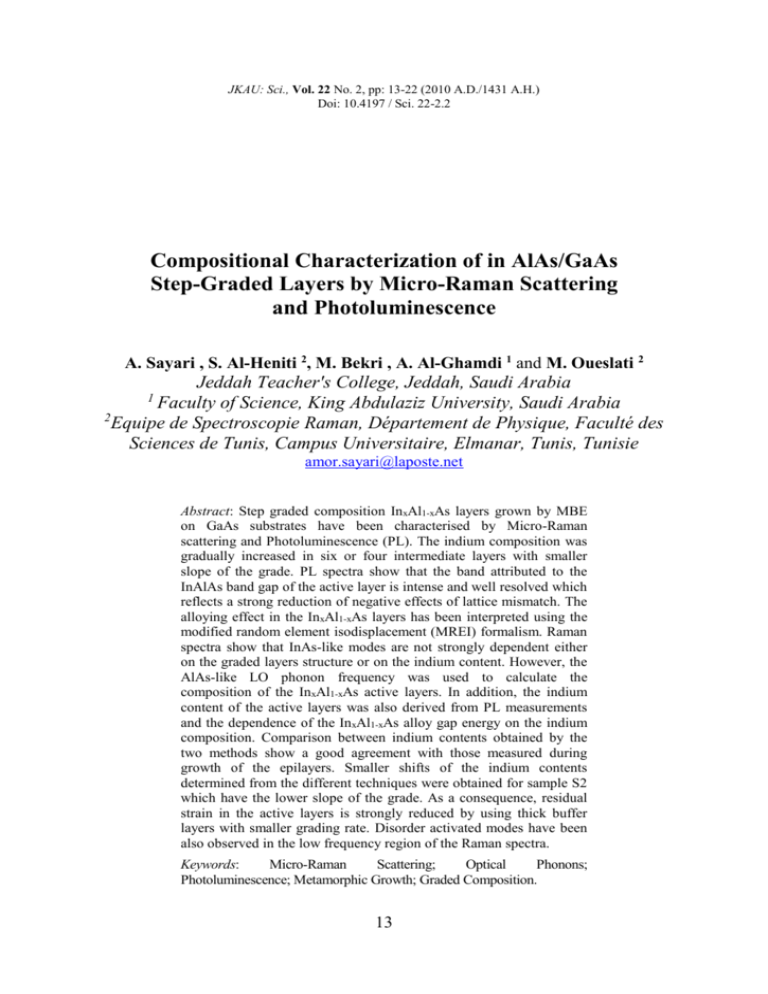
JKAU: Sci., Vol. 22 No. 2, pp: 13-22 (2010 A.D./1431 A.H.) Doi: 10.4197 / Sci. 22-2.2 Compositional Characterization of in AlAs/GaAs Step-Graded Layers by Micro-Raman Scattering and Photoluminescence A. Sayari , S. Al-Heniti 2, M. Bekri , A. Al-Ghamdi 1 and M. Oueslati 2 Jeddah Teacher's College, Jeddah, Saudi Arabia Faculty of Science, King Abdulaziz University, Saudi Arabia 2 Equipe de Spectroscopie Raman, Département de Physique, Faculté des Sciences de Tunis, Campus Universitaire, Elmanar, Tunis, Tunisie 1 amor.sayari@laposte.net Abstract: Step graded composition InxAl1-xAs layers grown by MBE on GaAs substrates have been characterised by Micro-Raman scattering and Photoluminescence (PL). The indium composition was gradually increased in six or four intermediate layers with smaller slope of the grade. PL spectra show that the band attributed to the InAlAs band gap of the active layer is intense and well resolved which reflects a strong reduction of negative effects of lattice mismatch. The alloying effect in the InxAl1-xAs layers has been interpreted using the modified random element isodisplacement (MREI) formalism. Raman spectra show that InAs-like modes are not strongly dependent either on the graded layers structure or on the indium content. However, the AlAs-like LO phonon frequency was used to calculate the composition of the InxAl1-xAs active layers. In addition, the indium content of the active layers was also derived from PL measurements and the dependence of the InxAl1-xAs alloy gap energy on the indium composition. Comparison between indium contents obtained by the two methods show a good agreement with those measured during growth of the epilayers. Smaller shifts of the indium contents determined from the different techniques were obtained for sample S2 which have the lower slope of the grade. As a consequence, residual strain in the active layers is strongly reduced by using thick buffer layers with smaller grading rate. Disorder activated modes have been also observed in the low frequency region of the Raman spectra. Keywords: Micro-Raman Scattering; Optical Phonons; Photoluminescence; Metamorphic Growth; Graded Composition. 13 A. Sayari et al 14 1. Introduction In the past few years, lattice mismatched growth has received a great attention particularly in HEMTs application[1,2]. Various buffer layers with compositional grades have been developed to obtain strain relaxation and misfit dislocation filtering within either InAlAs[35] or InAlGaAs[6,7] material grown on GaAs substrates. Metamorphic growth on GaAs offers a freedom of choice of the indium content in the device design combined with the advantage for avoiding InP substrates. The later substrates are more expensive and brittle than GaAs substrates. In the case of metamorphic InAl(Ga)As devices, InAlAs graded buffers were widely used because their effectiveness to reduce threading dislocation density and ensure good insolating properties. However, the optimization of these complex structures in order to achieve high performance of device requires optical characterization. In the present work, the samples characterized by micro-Raman scattering and PL are based on thick InAlAs layers with step-graded indium content and grown by MBE on (001)-oriented GaAs substrates. We have calculated the compositional fraction in the InxAl1-xAs active layers using micro-Raman scattering and PL measurements. Indium contents obtained from the two methods show good agreement with those measured during growth. 2. Experiment The samples investigated in the present work were grown by MBE on a (001)-oriented GaAs substrates. Samples S1 and S2 consist of three and five step graded InxAl1-xAs buffer layers respectively. The relative variation of the indium composition in the InxAl1-xAs buffer layers is about 10% for S1 and 5% for S2. Each step thickness of the InxAl1-xAs graded layers is 100 nm. The active layers of 100 nm thick and doped with silicon are In0.41Al0.59As and In0.37Al0.63As in sample S1 and S2 respectively. The InAlAs active layers surfaces were capped with a 5 nm of Si-doped GaAs to protect them from reaction with water vapour in the air. A schematic structure of the two samples is presented in Figure 1. Room temperature micro-Raman scattering experiments were performed in the backscattering geometry on the (001) surface by employing the 514.5 nm line of an argon-ion laser. Local heating of the sample was avoided by using low laser power on the sample (60 mW). The scattered light was dispersed by a triple spectrometer and the spectra were recorded using a CCD detector. Room temperature PL spectra were obtained by exciting the samples with a continuous ionized Argon laser (Ei=2.41 eV). The detection setup consists in a dilor triple monochromator and a photomultiplier tube with GaAs cathode. 15 Compositional Characterization of InAlAs/GaAs … GaAs:Si cap layer In0.37Al0.63As:Si GaAs:Si cap layer In0.34Al0.66As In0.41Al0.59As:Si In0.28Al0.72As In0.34Al0.66As In0.25Al0.75As In0.26Al0.74As In0.18Al0.82As In0.13Al0.87As In0.14Al0.86As Si-doped GaAs substrate (001) Si-doped GaAs substrate (001) (a) (b) Fig. 1: Schematic structures of step graded InAlAs layers grown on GaAs: (a) Sample S1 and (b) Sample S2. 3. Results and Discussion 3-1 Mico-Raman Results Figure (2) shows Raman spectra of the different InAlAs/GaAs step graded heterostructures recorded at room temperature and exited above the band gaps of the active layers (out of resonance). The InAlAs alloys exhibit two-mode behavior[8,9]; hence the major peaks in the spectra are assigned as the InAs-like and AlAs-like LO phonons. Besides these two modes, we observe also the disorder activated modes in the low frequency range and the GaAs optical phonons in the spectral range 260-300 cm-1. From Figure 2, a broad and intense peak is observed at the frequency 231 cm-1. This peak is attributed to the InAs-like LO mode of the InAlAs active layer[8,9]. This peak showed an asymmetric shape at low energy which is due to 16 A. Sayari et al the shouldering of the InAs-like TO mode. Appearance of the InAs-like TO mode, which is normaly forbidden in backscattering geometry, is activated by alloy disorder. In the low frequency region, the broad band around 188 cm-1 and the weak features observed at frequencies 140, 170 and 205 cm-1 are attributed to disorder activated longitudinal acoustical (DALA) vibrations[8,10]. The observation of such modes means that non-zero q-vector phonons which are activated by disorder contribute to the scattering process[9,11]. We note that InAs-like LO mode of the active layers is not strongly dependent either on the graded profile of buffer layers or on the indium composition because there is no clear frequency shift and shape modification of Raman peaks[8,9]. Therefore, indium contents of the active layers cannot be derived from InAs-like LO phonon frequency. InAs-like band T = 300K Ei = 2.41eV Raman Intensity (a. u.) DALA GaAs band AlAs-like band S1 S2 125 150 175 200 225 250 275 300 325 350 375 400 425 -1 Raman Shift (cm ) Fig. 2: Raman spectra of the studied samples recorded at room temperature with an exciting energy Ei= 2.41 eV. Observation of the disorder activated modes, InAs- and AlAs-like LO phonon modes and the GaAs optical band. Figure 3 shows an extension, into the AlAs-like optical phonon region, of the spectra of Figure 2 for samples S1 and S2. The scattering in the frequency range of the optical AlAs-like region is dominated by the LO phonons of the InxAl1xAs layers. The observed broad structures result from the contribution to the Raman scattering of the LO modes from the different InAlAs layers. The 17 Compositional Characterization of InAlAs/GaAs … positions of all these optical phonons depend on the compositional fraction since AlAs-like optical mode is strongly dependent on the indium content[8]. Therefore, it is possible to determine the compositional fraction from the frequency of this phonon because PL measurements on these samples show that residual stress in the active layers has been strongly reduced[12,13]. Raman Intensity (a. u.) T=300K Ei=2.41eV S1 S2 320 340 360 380 400 -1 Raman Schift (cm ) Fig. 3. Raman spectra of samples S1 and S2 recorded in the AlAs-like optical region: Observation of the AlAs-like LO and TO phonons from the different InxAl1-xAs layers. In order to estimate the accurate phonon frequencies, the raw data were fitted with suitable number of Lorentzian functions and a proper background in the interval 310-410 cm-1. Figure 4 shows an example of line-shape fitting for sample S2. The measued frequencies of the AlAs-like LO phonon for the two samples are shown in Table 1. The quadratic dependence of the AlAs-like LO phonon frequency on the indium composition is given by the following equation according to the MREI model[14]. AlAs 404.1 78.5.x 7.096.x LO 2 (1) By substituting the experimental values of the AlAs-like LO phonon frequency in the above equation, one can estimate the compositional fraction of the active layers (xR) which are presented in Table 1. 18 A. Sayari et al Table (1). The indium contents of the InAlAs active layers obtained from Raman measurements (x R) and PL spectra (x PL) compared to those measured during growth of the graded layers (x G). Sample xG S1 S2 0.41 0.37 LO ω AlAslike (cm 1 xR Eg(eV) xPL 0.439 0.377 1.67 1.83 0.440 0.383 ) 370.7±0.5 375.2±0.6 The sharp peak clearly seen at ~ 391 cm-1 in Figure 3 is attributed to AlAslike LO mode of the initial layer of the grade (xi = 0.13 for S1 and xi = 0.14 for S2). The vertical dashed line shows that there is a small shift due to the difference between indium contents of the initial layers of the grade. Calculations of AlAs-like LO phonon frequencies for the two xi compositions using Eq. (1) confirm our attribution. We note that the shift between experimental and theoretical AlAs-like LO phonon frequencies of the initial layers of the grade is expected, since these layers are highly strained regarding the difference between their lattice parameters and that of the GaAs substrate. Raman spectra show that AlAs-like LO and TO phonons from the initial and final layers of the grade contribute to the Raman scattering in the two samples. However, additional contribution to the scattering from the intermediate layers appears only in the fitted Raman spectrum of sample S2. The peak observed at ~382 cm-1 in Figure 4 is due to the AlAs-like LO mode of the In0.28Al0.72As layer of sample S2. The emergence of the later peak may be attributed to the relaxation process starting from this layer of the grade in sample S2. Raman Intensity (a. u.) LOAlAs(x= 0.37) LOAlAs(x= 0.14) LOAlAs(x= 0.28) S2 TOAlAs(x= 0.37) 310 330 350 370 390 410 -1 Raman Shift (cm ) Fig. 4: Line shape fitting of Raman spectrum obtained from sample S2 in the AlAs-like optical region. The doted lines present various lorentzian components, the solid line is their sum and the empty circles are experimental data. 19 Compositional Characterization of InAlAs/GaAs … 3-2 Photoluminescence Measurements The room temperature PL spectra of samples S1 and S2 are shown in Figure 5. As we have shown in previous reports[12,13], the PL spectra of the InAlAs step graded layers at room temperature display two main PL bands A and B. The A band appears in S1 and S2 at the same energy 1.424 eV, which is the GaAs gap. This band is due to band recombination in GaAs. The B band appears at the energies 1.67 eV and 1.83 eV in S1 and S2 respectively. This band is attributed to the InxAl1-xAs band gap of the active layer. The PL B band shows a red shift with increasing indium composition. This agrees with previously published reports[15,16]. The B band is intense and well resolved reflecting a strong reduction of the negative effects of lattice mismatch. The indium composition for each active layer was evaluated using PL measurements and the indium content dependence of the InxAl1-xAs gap energy at room temperature as given in Ref. 17: E g (300K ) 3.02 3.39.x 0.74.x 2 (2) Ei = 2.41 eV PL Intensity (a. u.) A T = 300 K B A S1 B S2 1.4 1.5 1.6 1.7 1.8 1.9 2.0 Energy (eV) Fig. 5: Room temperature PL spectra of samples S1 and S2: Observation of the InAlAs active layer luminescence band B. A. Sayari et al 20 The obtained indium compositions of the active layers from PL measurements (xPL) and Eq. (2), shown in Table 1, are in good agreement with those measured during growth of the epilayers. Comparison of the indium contents displayed in Table 1 shows a good agreement particularly for sample S2 which has the smaller grading rate. As a consequence, residual strain in the active layers is strongly reduced by using thick graded InAlAs buffers with low In. Raman scattering and PL techniques are much preferred routine characterization methods, compared to other destructive methods. 4. Conclusion We have estimated the compositional fraction in various InxAl1-xAs active layers by measuring AlAs-like LO phonon frequencies and the equation derived from the MREI model. Independently, the indium contents of these active layers were also determined using PL measurements. Good agreement between the indium contents derived from the two methods and those measured during growth of the epilayers was obtained. This result indicates that residual strain in the active layers is strongly reduced by using thick InAlAs graded buffers with smaller grading rate. Raman spectra show that InAs-like LO phonons are not strongly dependent either on the buffer structure or on the indium composition of the InAlAs active layers. Raman scattering and PL techniques are the best non-destructive methods to analyze the compositional fraction in In xAl1-xAs active layers. References [1] Shang, X.Z., Jing Wu, Wang, W.C., Wang, W.X., Huang, Q. and Zhou, J.M. (2007) Solid State Electronics 51: 85. [2] Hwang, K.C., Chao, P.C., Creamer, C., Nichols, K.B., Wang, S., Tu, D., Kong, W., Dugas, D. and Patton, G. (1999) IEEE Electron. Dev. Lett. 20: 551. [3] Chauveau, J.-M., Cordier, Y., Kim, H.J., Ferré, D., Androussi, Y. and Di persio, J. (2003) J. Cryst. Growth 251: 112. [4] Cordier, Y., Ferré, D., Chauveau, J.–M. and Dipersio, J. (2000) Appl. Surface Science 166: 442. [5] Cordier, Y. and Ferré, D. (1999) J. Cryst. Growth 201/202: 263. [6] Towe, E., Sun, D. and Bennet, B. R. (1994) J. Vac. Sci. Technol. B12: 1099. [7] Haupt, M., Kohler, K., Ganser, P., Muller, S. and Rothemund, W.J. (1997) Cryst. Growth 175/176: 1028. [8] Emura, S., Nakagawa, T., Gonda, S. and Shimizu, S. (1987) J. Appl. Phys. 62: 4632. 21 Compositional Characterization of InAlAs/GaAs … [9] Juang, Y.D., Chan, Y.L., Jiang, G.C., Shieh, J.L., Pan, J.W., Chyi, J.J., Tse, W.S. and Chow, T.C. (1995) Chinese Journal of Physics 33: 57. [10] Bulbul, M.M., Farrant, G.D. and Smith, S.R.P. (2001) Eur. Phys. J. B24: 3. [11] Mlayah, A., Carles, R., Sayari, A., Chtourou, R., Charfi, F.F. and Planel, R. (1996) Phys. Rev. B53: 3960. [12] Yahyaoui, N., Aloulou, S., Chtourou, R., Sfaxi, A. and Oueslati, M. (2006) Appl. Surface Science 253: 292. [13] Yahyaoui, N., Aloulou, S., Chtourou, R., Sfaxi, A. and Oueslati, M. (2008) Thin Solid Films 516: 1604. [14] Pavesi, L., Houdré, R. and Giannozzi, P. (1995) J. Appl. Phys. 78: 470. [15] Singh, J. (1993) Physics of Semiconductors and their Heterostuctures, Mc Graw Hill. [16] Katz, A. (1992) Indium Phosphide and Related Materials, Artech House, Boston, [17] Wakefield, B., Halliwell, M.A.G., Kerr, T., Andrews, D.A., Davies, G.J. and Wood, D.R. (1984) Appl. Phys. Lett. 44: 341. 22 A. Sayari et al دراسة الخصائص التركيبية للطبقات InxAl1-xAs/GaAs المتدرجة النسبة بمطيافية رامان والتألق الفوتوني السياري ،صالح الحنيطي ،1مصطفى البكري ،أحمد الغامدي 1و محرز الوسالتي عمرو ّ 2 كلية التربية بجدة -جامعة الملك عبدالعزيز -المملكة العربية السعودية 1كلية العلوم ،جامعة الملك عبدالعزيز-جدة -المملكة العربية السعودية 2قسم الفيزياء ،كلية العلوم بتونس ،المركب الجامعي ،المنار -تونس تمتتت د ارستتة الطبقتتات InxAl1-xAsالمتدرجتتة النستتبة والتتتي المستتخلصّ : رستتبت بطريقتتة MBEباستتتخدام مطيافيتتة ارمتتان والتتتألق الفوتتتوني تتتم ّ رفع نسبة اإلنديوم تدريجيا للحصول على ستة أو أربع طبقات وستيطة بحيتتك يكتتون ميتتب تتتدرو نستتبة اينتتديوم صتتلير تبت ّتين أطيتتا أن الشتريا المنستتوب التتى النطتتا المحصتور للطبقتتة النشتتطة الفوتتتوني ّ الت تتألق InAlAsمفص تتول ،وع تتالي الش تتدة ،مم تتا يعك تتس انخفاا تتا قوي تتا ل تتار الس تتلبية ،لع تتدم التط تتابق الش تتبكي ب تتين الطبق تتة التحتي تتة ،)GaAsوهت ت فسر تأ ير الخلا المعدني في ه الطبقات باستخدام نظرية الطبقات ّ أن اينم تتا م تتن ن تتو InAsال تعتم تتد MREIوتب ت ّتين أطي تتا ارم تتانّ ، عل تتى تركيب تتة الطبق تتات المتدرج تتة ،وال عل تتى نس تتبة اين تتديوم في تتا ف تتي المقابتتب ،استتتعملت تتترددات اينمتتا الطوليتتة متتن نتتو ،AlAsلتحديتتد نسبة اينديوم فتي الطبقتات النشتطة InxAl1-xAsوزيتادة علتى لتك ،تتم اس ت تتتنتاو نس ت تتبة اين ت تتديوم ف ت تتي الطبق ت تتة النش ت تتطة م ت تتن قياس ت تتات الت ت تتألق 23 … Compositional Characterization of InAlAs/GaAs الفوتتتوني ،واعتمتتاد طاقتتة النطتتا المحاتتور للخلتتيا المعتتدني InxAl1- xAsعلتتى نستتبة اينتتديوم ان مقارنتتة نستتبة اينتتديوم المتحصتتب علي تتا بتتالطريقتين تظ تتر اتفاق تا جيتتدا متتع تلتتك التتتي قيستتت بايشتتعة الستتينية، عن تتد ترس تتيب الطبق تتات الخط تتأ ف تتي نس تتبة اين تتديوم المتحص تتب علي تتا للعينة ،S2التي لدي ا أدنى ميب بالتقنيات المختلفة ،كانت أقب بالنسبة ّ فت تتي تت تتدريأل نست تتبة اينت تتديوم ونتيجت تتة ل ت ت لك ،ف ت ت ن بقايت تتا االنفعت تتال فت تتي الطبقات النشطة قد تقّلصت بقدر كبير ،باستخدام طبقات سميكة ،متع ميب أصلر لتدريأل نسبة اينديوم الحظنا أياا وجود أنمتا فواتوية في منطقة الترددات المنخفاة من أطيا رامان A. Sayari et al 24
